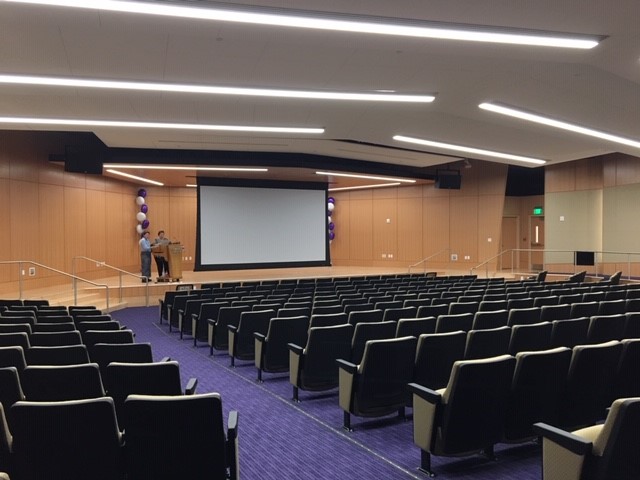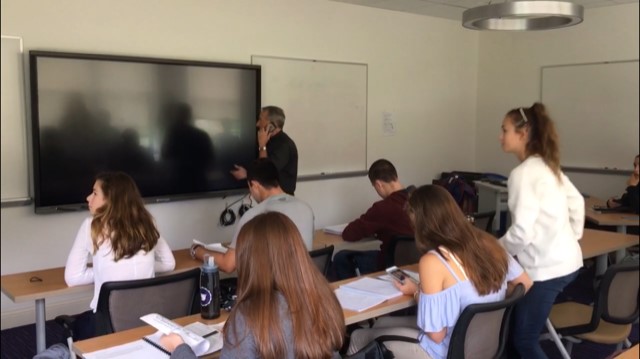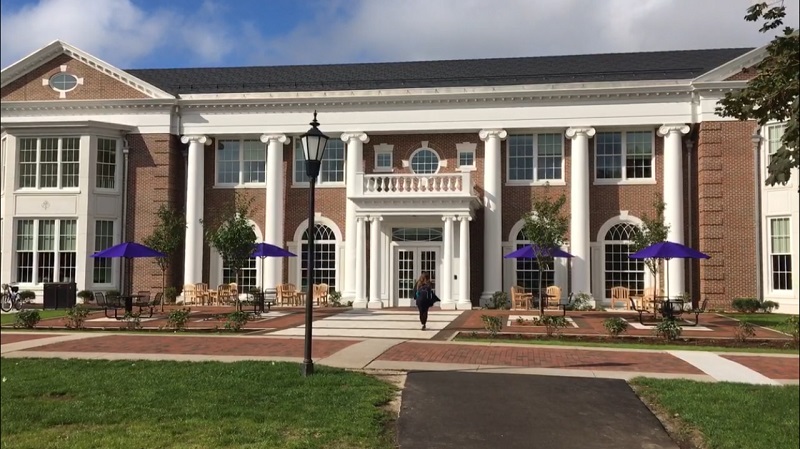Stonehill College, a private school 20 miles south of Boston, has all the earmarks of a traditional New England institute of higher learning – a grassy quad connecting brick buildings, reputation for academic excellence, and even a venerable mansion that looks down on the campus from high upon a hill.
[related]To prospective students taking the campus tour, there is a lot to like about the look and feel of Stonehill College.
However, those compelling features are no longer enough when it comes to the increasingly competitive world of college recruiting, Stonehill leadership acknowledges.
The school recently unveiled its Thomas and Donna May School of Arts and Sciences. Not only is the new building home to the school’s religion, philosophy and history departments, it’s also the first stop for prospective students as they embark on those campus tours.
That’s strategic, of course. The Thomas and Donna May School of Arts and Sciences reflects an important priority for Stonehill College — to preserve the academic ideals that helped establish its reputation while evolving its technologies and the collaborative learning environments that it provides to its students. That’s very much on display while walking through the new building.
“We know we can’t rest on our laurels. We know that we have to continue to step up our game in terms of what we offer,” says Martin P. McGovern, Stonehill College’s director of communications and media relations.
Campus Collaboration Technologies and College Recruiting
Walk through any college campus and you’ll find a recurring theme – students huddled together and collaborating around something. Maybe they’re crowding around a café table watching a Snapchat video on a phone.
Maybe they’re gathered in a student union prepping for a group presentation while scrolling through a tablet.
College students have a comfort level with and expectation for interactive collaboration technologies. Collaboration is part of life and learning. The challenge falls on universities, therefore, to facilitate that collaboration.
From a college recruiting standpoint, it’s also important to showcase collaborative spaces.
By working with AV consultant Cavanaugh Tocci Associates and AV integration firm HB Communications, Stonehill College emphasizes opportunities for collaboration in the Thomas and Donna May School of Arts and Sciences.
“This building is really helpful when people want to work together on group projects,” says Rachel Riani, Stonehill College class of 2019. “If you need an environment that [allows] you to work together in a small group it’s effective for that.”
North Haven, Conn.-based HB Communications, for its part, has a wide portfolio of higher education customers that, like Stonehill, is increasingly demanding audio, video and collaborative technologies.
The Thomas and Donna May School at Stonehill project represents a “big picture trend,” says Peter Charland, HB Communications’ executive VP of global operations and services.
“I’m seeing this become very mainstream. Because of the ubiquity of media in people’s lives you’re seeing more schools like Stonehill that embrace collaboration technologies.”
In the case of Stonehill’s new building, there are several connected huddle spaces for students to gather for group collaboration.
There’s a state-of-the-art auditorium providing a platform for large-scale presentations, including debates and concerts. Meanwhile, a “presentation room” is geared for smaller in-person presentations but it’s broadcast ready, allowing Stonehill thought-leaders to more easily act as news sources by connecting with, for instance, cable networks.
Most importantly, of course, the classrooms in the Thomas and Donna May School of Arts and Sciences feature interactive whiteboards, providing a platform for professors to adapt their teaching style to students’ needs.

The auditorium in Stonehill College’s Thomas and Donna May School of Arts and Sciences features multiple floor boxes on the state, says Michael Pietrowski, director of media technology services for Stonehill College. “If we have a panel discussion or small concerts and you need phantom-powered capability mics, etc, instead of running cable everywhere, you have it all right in a row and in the middle avoiding aesthetic issues and tripping hazards.”
Technology to Bridge Generations
There is an inherent challenge to smart classroom collaboration technologies.
On the one hand, it’s designed to create an interactive learning environment that’s in sync with how young students take in information. On the other hand, the person that’s doing the interactive teaching brings a different perspective on technology.
Technology “is important to us because we operate in a changing environment for higher education. Demographics are changing,” McGovern says.
In the case of Stonehill’s Thomas and Donna May School, however, the “interactive whiteboards seem to be very easy for faculty to use,” says Michael Pietrowski, director of media technology services.
It’s important, he says, to present both professors and students with interactive collaboration technologies that are intuitive. Otherwise, utilization drops.
“One of the goals was to bring this type of technology such that when students come it’s a quick read-and-learn for them,” Pietrowski says.
“Then when they do their assignments or present to other classmates, it’s all right there. These will allow the students to practice their craft before they commence here from college.”
That, of course, is the ultimate goal – to prepare students for life and careers after college. Providing a platform for collaboration technologies is important along those lines, but it’s far from the only factor.
Having a technology-infused environment in which it’s easy for students to collaborate is “imperative,” McGovern says. “It’s a responsibility that we do it, do it well and do it right. However, I think there has to be a balance between a complete and utter dependence on technology.”
Related: Why Students Don’t See the Career Opportunities in AV
For a traditional school like Stonehill College the focus should be on “integrating technology into the educational structure and to keep updating it, but we also have to inculcate in the students’ other skills that they will need that are not going away,” McGovern adds.
“You need to be able to be articulate in an oral presentation. You still need to craft a strong, effective, compelling argument. You still need to be able to debate quickly, smartly, civilly. You need those skills. I don’t see it as an either-or.”
Striking that balance, fostering an educational environment that’s both technology-immersed and timeless, is an important goal when it comes to college recruiting.
Prospective students and their parents should feel confident in the collaboration technologies that the school will provide. “It is an attraction, I think, for parents and families, given what they invest in an education today,” McGovern acknowledges.
Technology, therefore, “is important to us because we operate in a changing environment for higher education. Demographics are changing. The technological changes that are reshaping the way people are educated, the speed with which life operates today, when you overlay them and see those things interacted, it’s a very different world.”

The smart boards featured in most of the classrooms in Stonehill College’s Thomas and Donna May School are designed to be intuitive for both professors and students, says Michael Pietrowski, director of media technology services. “They can log on, do their PowerPoint presentations, look at YouTube, send out assignments and interact with other locations.”







































